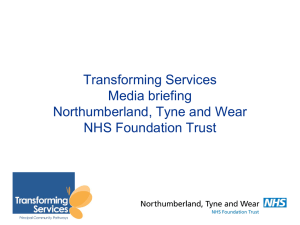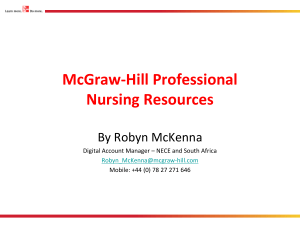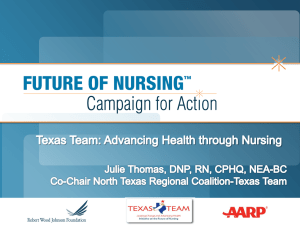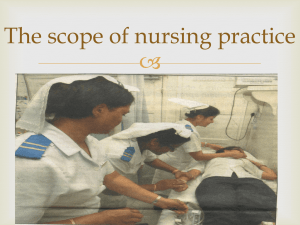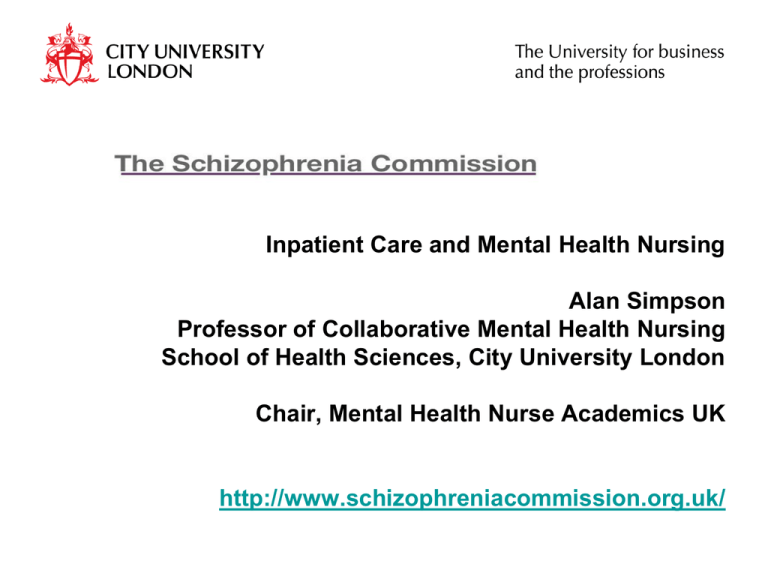
Inpatient Care and Mental Health Nursing
Alan Simpson
Professor of Collaborative Mental Health Nursing
School of Health Sciences, City University London
Chair, Mental Health Nurse Academics UK
http://www.schizophreniacommission.org.uk/
Inpatient Care and Mental Health Nursing
• What is the purpose of inpatient care for people with
schizophrenia – what are we trying to do?
• What do mental health nurses do well?
• What could we do better?
• What is it not?
• What else might help? Any alternatives?
Acute mental health inpatient care: background
• Long been subject to criticisms:
• Most expensive component of care
• High bed occupancy, shortage of
beds and swift/delayed discharge
• Generally accepted that alternative
community services will never fully
dispense with the need for inpatient
beds
• Violence against staff and service
users, sexual harassment, theft
• Drug and alcohol problems
• Generally unpopular with service
users and carers
• Mental health service research has
focussed on the development of
community services so little evidence
about what works in inpatient care
• Specialist staff education/training
• Boredom, lack of activity, lack of stafffocused on community
patient interaction, poor environment
• Recent guidelines and initiatives in
• (MHAC 2005. Simpson 2008, Bowers
attempt to refocus and improve
et al 2009, Jones et al 2010)
quality of inpatient care
Acute care guidelines and initiatives
• Mental Health Policy Implementation • Releasing time to care - The
Guide: Adult Acute In-patient Care
Productive Ward (NHS Institute for
Provision (DH, 2002)
Innovation and Improvement)
• Delivering race equality in mental
health care (DH 2005)
• Star Wards (Janner 2006)
• inspiring, collecting and disseminating best
practice in inpatient care
• AIMS (RCPsych)
• standards-based accreditation programme
to improve the quality of care in inpatient
mental health wards
• PET (Bowles & Howard 2003)
• Protected Engagement Time
• NICE Schizophrenia guidelines
(RPS/RCP 2010 updated)
• http://www.nice.org.uk/nicemedia/pdf/
CG82FullGuideline.pdf
• NEW: NICE clinical guideline 136:
(December 2011)
• Service user experience in adult
mental health: improving the
experience of care for people using
adult NHS mental health services
• www.nice.org.uk/cg136
Inpatient admissions and schizophrenia
Schizophrenia and bed use
Detentions in hospital
• 32.7 per cent of the bed days used
• 49,417 detentions 2009/10
during 2009/10 (over 2.5 million out of
(including detentions subsequent to
a total of approx 7.9 million bed days)
admission etc)
were for people with a diagnosis of
• Up by 3.5 per cent on previous year
‘Schizophrenia’ or similar disorders
(F20-F29)
• 30,774 formal admissions to hospital
• Up 7.3 per cent on previous year
• Double the number of bed days for
the next highest diagnostic category
• No breakdown by diagnosis
(mood/affective disorders)
• Evident that people with
• (Health and Social Care Information
schizophrenia make up a large
Centre, 2011)
proportion of those on acute wards
and increasing proportion there
against their will
Why are people admitted to hospital?
• Severe mental illness PLUS ‘crisis’
• E.g. severe symptoms; deterioration; risk - appears likely to harm
themselves or others; stressors (bereavement); failure in activities of
daily living; ‘intolerable’ behaviour; or need for assessment; AND
• They or their family/community require respite, AND/OR
• Filtered via supports available (family, crisis team, tolerance, legal
regulation (supervision orders), bed availability, etc
• Plus, other health and life problems, e.g. social withdrawal,
alcohol/drug problems, physical ill health, relationship problems, debt
• All – plus previous experiences of inpatient care - serve to impact on
expectations, hopes, fears re admission
• (Bowers et al 2005, Bowers et al 2009)
‘Complex Care Trajectories’
• Whole systems approach and ‘complex care trajectories’
• Tilted by individual-level health events (e.g. experiencing a crisis), but
also by system features (e.g. the departure of key staff, poor
hospital/community communication)
• Show important roles played by support staff and informal carers and
need to for skilled care co-ordination and therapeutic interventions
• (Hannigan & Allen 2011)
The function of acute psychiatric wards
• Safety - most admissions
emergencies or risk to self or others
• Safety, containment, managing risk,
assess, re-assess
• Assessment – what’s going on? Why
the crisis?
• Assess nature, type and extent of
problems, constant presence
• Treatment
• Medication, presence+, being
alongside, rapport, therapies
• Meeting basic self care needs
• Feeding, drinking, attending to
personal hygiene
• Physical healthcare
• Diagnostic procedures, care and
treatment of conditions, info
• Management, organisation and coordination
• Organising and co-ordinating MDT,
liaising with family and community
services, MH Act documentation,
records, etc etc etc
• (Bowers et al 2005, Bowers et al 2009)
Mental health nursing care: Nurse-patient interaction
• Bulk of 24 hour care provided by
MHNs and their assistants
• Reveals that nurse communication
involves interpersonal approaches
and methods that exemplify highly
• Patient studies/surveys often praise
developed communication and
nursing care but want more of it or
personal skills designed specifically
more psychological interventions (Bee
for this challenging setting.
et al 2006)
• Overlaps with recent work to identify
• Long history criticising lack of nursetechniques and approaches employed
patient interactions – much nurse
by ‘expert’ nurses when interacting
therapeutic activity behind the scenes
with people who are acutely psychotic
or involve subtle ‘low visibility’ skills
(Bowers et al 2010)
• http://www.iop.kcl.ac.uk/iopweb/blob/d
• NEW: Cleary et al 2012 Review and
ownloads/locator/l_436_Talking.pdf
synthesise 23 papers (18 studies)
investigating nurse-patient interaction • Research how we best develop and
in acute inpatient care
enable use of such skills…
Nurse-Patient Interactions Skills (Cleary et al 2012)
1. Sophisticated communication
• Relating through the ordinary
• Weaving psychological interventions
with physical care and practical matters
• Listening –Understanding- responding
• Negotiation
• Interpersonal calming
• Empathy under duress
2. Subtle Discriminations
• Penetrating the psychosis
• Individual-Milieu Pattern Recognition
• Managing Control-Freedom Tensions
3. Managing Security Parameters
•
•
•
•
•
Rules Management
Prevention of Harm
Managing Diversity
Crisis Management
Limit Setting
4. Ordinary Communication
•
•
•
•
•
Showing Interest
Giving Information
Being with, and Being There for
Knowing the Patient
Experiencing Patients’ Progress
5. Nursing Team Reliance
• Exchanging Patient Information
• Nurse-Nurse Communicative Coherence
• Debriefing with other Nurses
6. Personal Characteristics important
to patients
•
•
•
•
•
•
Imagination
Sense of Humour
Respecting Patients’ Intrinsic Humanity
Non-judgementalism
Patience and perseverance
Internal calmness in the face of fire
Preparing for psychosocial interventions
• Nurses can provide an atmosphere that maximises safety and containment
and prepares the person for more intensive or structured psychosocial –
therapeutic interventions that aid recovery
• CBT, adherence therapy, motivation, family work, etc
• Nurses work with and alongside the fractured state to help the person find
themselves and to find their way
• Short meetings, getting used to sitting with a person, beginning to talk about
things
• ‘sometimes carrying and then walking alongside on the path’
• Different to therapy where two people choose to be there and agree on the
need to be there
Structured Activities
• Boredom and lack of meaningful
occupation is major complaint
(Lelliott & Quirk 2004).
• Availability of therapeutic activities
varies widely (CHI 2004)
• Star Wards -– focus on increasing staffpatient interaction and patient activities
• Evaluation found big increase in patientfocused activities and patient contact
(Simpson & Janner 2010)
• http://www.starwards.org.uk/publications
• Challenges for OTs due to acuity and
swift discharges (Simpson et al 2009) • Overwhelmingly described in positive
terms, including ‘rewarding’,
‘interesting’, ‘fun’ and ‘innovative’.
• Leads to frustration, aggression,
leaving the wards (absconding), etc
• Underpinned by an Appreciative
Enquiry approach - has hundreds of
• Programme of structured activities
staff and patients enthusiastically
reduces incidents, especially severe
creating and sustaining high quality
self-harm (Bowers et al 2008)
initiatives – lessons to learn!
Room for improvement: physical healthcare
• Physical healthcare
• Lack of good evidence-based
• Increased risk of death from
approaches to tackle this but number
circulatory conditions, infections and
of developments taking place
endocrine disorders
• Higher rates of smoking
• Need for far greater focus and
• Higher rates of cardiovascular
research
disease
• Less likely to exercise and more likely
• (Robson & Gray 2007, Tosh et al
to have poor diets
2011)
• Increased risk of weight gain and
diabetes
Room for improvement: Substance use & sexual health
• Alcohol and drug use
• Evidence that people with schizophrenia
have considerable problems with alcohol,
cannabis use and other drug use increases chances of hospital admission
(Miles et al 2003, Menzies et al 1996)
• Increase in admissions for schizophrenia
and substance misuse - challenge on
wards (Simpson et al 2011)
• Limited evidence about effective
interventions but stepped approach to
alcohol should be applicable:
• Screening & assessment
• Brief advice & brief interventions
• MH nurse education and development
needs to include knowledge and skills to
work therapeutically with patients
presenting with dual diagnoses
• Sexual health
• Many people with schizophrenia have
difficulties in their intimate relationships being victimised/exploited, not having the
skills to find and maintain a relationship, and
also limited understanding of sexual safety
(prevention of BBV and STI infection).
• Also evidence of association between child
sex abuse and many psychiatric disorders
including schizophrenia with implications for
practice (Read et al 2005, Jonas et al 2011)
• Sexual health not really on radar but could
be embedded in the public mental health
agenda (Hughes & Gray 2009)
Room for improvement: Families, carers and discharge
• Families and carers
•
•
•
•
Engagement, information, signpost
Family champions on wards
Learn from families & carers
‘Triangle of care’
• http://static.carers.org/files/caretriangle-web-5250.pdf
• Patients as parents
• Needs of parents and children & familyfriendly services (Burbach & Stanbridge
2006, Askey et al 2009)
• http://www.meridenfamilyprogramme.com/
• Preparing for discharge
• Maintaining recovery postdischarge
• Flexible staff, home visits, peer support
• Peer support alongside CMHTs – need for
more research into different models
(Simpson et al in press; Gillard et al
ongoing study)
Morale is good: Maintain staff morale
• Two studies found good morale
amongst staff on inpatient wards
(Bowers et al 2008, Totman et al
2011)
• Good morale important for:
• strong therapeutic alliances
• positive patient experiences, and
• successful implementation of
initiatives to improve care
• Inpatient staff feel sustained in their
potentially stressful roles by:
• mutual loyalty and trust within
cohesive ward teams
• clear roles
• supportive ward managers
• well designed organisational
procedures and structures
• Perceived threats to good morale
include:
• Staffing levels that are insufficient
for staff to feel safe and able to
spend time with patients
• High (perceived) risk of violence
• Lack of voice/involvement in
decisions and in the wider
organisation
• Need to:
• Increase employee voice
• Design jobs to maximise autonomy
within clear structured protocols
• Enable and promote greater staffpatient contact
• Improving responses to violence
Nursing education
• The new mental health field practice learning outcomes include topics
specifically relating to schizophrenia, e.g. in the Communication and
interpersonal skills domain:
• 1.1 Mental health nurses must use skills of relationship-building and
communication to engage with and support people distressed by hearing
voices, experiencing distressing thoughts or experiencing other perceptual
problems. (NMC, 2010)
• Nb. We have not had such mental health specific skills detailed before for
student nurses to achieve.
• Important to ensure that pre-registration nursing education continues to have a
mental health specialist field – has been under threat
Relational care models (e.g. Soteria Network)
• Consideration of alternatives to inpatient care, e.g. crisis houses
• Consideration of relational care models, e.g Soteria Network
• http://www.soterianetwork.org.uk/
• Raising the possibilities of minimal medication or no medication alternative care
provision
• Systematic review of Soteria Paradigm for treatment of people with
schizophrenia (Calton et al 2008) – 3 controlled trials found equal and in some
areas better results compared with conventional, medication-based approaches
• More investment in research into alternative approaches required
Thanks
• Members of Mental Health Nurse Academics UK
• http://mhnauk.swan.ac.uk/main.htm
• Geoff Brennan, Nurse Consultant at Camden and
Islington NHS Foundation Trust, London
• Bonus slides….
Mental health nursing
• The United Kingdom (including England) has one of the higher ratios of mental
health nurses (MHNs) to population, with approximately 104 nurses (MHNs) per
100,000 population (WHO 2005)
• There are approx 47,000 registered MHNs working in the National Health
Service (NHS) in England (DH 2005) and several thousand more working in the
independent sector.
• In the NHS, MHNs constitute 13% of all whole time nursing posts(DH 2005).
• Education (training) is typically a 3-year long diploma or degree level course at
pre-registration level. Some content is shared with other nursing students.
• MHNs work with all age groups and in all areas of service delivery, for example
inpatient care, acute and long-term community teams, general hospital liaison
services, drug and alcohol services and forensic services.
A cluster of concerns
• Payment by Results (PBR)
• Will clusters reinforce separation of disorders?
• Will individual needs be taken into account (with all the resultant
complexity) or will services provide a standard care plan according to
the cluster?
• Dual diagnosis nurse consultants concerned that if someone doesn’t
neatly fit the dual diagnosis cluster, then their co-morbidity wont be
addressed
Primary Care and Mental Health Measure (Wales)
• Primary Care
• Health inequalities - variable
physical and mental health care
• Inadequate knowledge and skills of
the Primary Care workforce
• Routine physical investigations may
not be offered (e.g. Blood Pressure,
Cervical Screening) and contribute
to higher rates of mortality
• Lack of support for carers
• (House of Commons Health
Committee 2009; Bunting et al;
date unknown; Oud et al 2007)
• Mental Health Measure (Wales)
• Legislative arrangements (Law) in
respect of the assessment and
treatment of people with mental
health problems. Includes:
• Primary care assessments,
treatment, info and referral
• Care co-ordination and planning
• Independent mental health
advocacy for all
• (Welsh Assembly Govt 2011)


